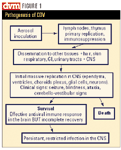Mapping the pathogenesis of canine distemper virus
Canine distemper is a debilitating, persistent infection of the nervous system, caused by an enveloped single-stranded RNA virus that belongs to the family of Paramixovirid?, Morbillivirus genus.
Canine distemper is a debilitating, persistent infection of the nervous system, caused by an enveloped single-stranded RNA virus that belongs to the family of Paramixoviridae, Morbillivirus genus.
Following inoculation, the canine distemper virus (CDV) replicates in the lymphatic tissue, and then spreads systemically to several organs, such as the skin, the upper respiratory tract and the central nervous system (CNS). Massive replication initially may result in respiratory and neurological signs including cerebellovestibular disease, ataxia, blindness, seizures and death (especially in young animals). If the initial immune response is effective enough, clinical recovery can occur.
However, this recovery often is not complete and the CDV moves into a so-called "persistent infection" mode, which "hides" from the immune system within the CNS (Figure 1). This persistent infection stimulates a low-grade but constant immune response, which results in tissue damage over the long term (ACVIM Forum in 2005 Marc Vandevelde, Dr. Med. Vet., DECVN, "Pathogenesis of distemper infections in the nervous system").

Figure 1
There are several peculiarities in CDV infections that cause this persistent infection. One strategy the CDV uses to hide from the immune system is restricted infection. Here the virus releases a minimal amount of virus particles into the extracellular space (where they are visible to the immune system). In this case, following entrance into the cell, the virus transcripts mRNA, but the translation is minimal, and "visible" virus protein is lacking.
Another peculiar feature of CDV is that often the virus fails to destroy the host cells (CNS cells and keratinocytes) by not causing cell-to-cell fusion. In this non-cytolytic effect, a certain part of one of the surface proteins of the virus is primarily responsible.
In the chronic stage, the disease is mainly demyelinating. This demyelination is primary, and due to the degenerative changes of the oligodendrocytes (not axonal degeneration). One week after initial infection, the oligodendrocyte undergo metabolic changes. About two weeks later, morphological changes are visible, such as stumped processes, swelling of the cytoplasm and foamy appearance. However, necrosis is not a feature. As a result of the changes in the oligodendrocytes, myelin maintenance processes become deficient, which results in demyelinization. The CDV causes white matter damage similar to the human disease multiple sclerosis. Dr. Vandevelde also notes that "the question can be raised whether breed-specific encephalopathies in dogs, which are subacute to chronic, sometimes fluctuating, inflammatory diseases, may result from persistent infections (ACVIM Forum 2006 Marc Vandevelde, Dr Med. Vet. DECVN, "Persistent nervous system infections").
Another potential cause of myelin damage are the toxic factors (oxygen radicals), which are released during phagocytotic activity of the up-regulated macrophages.
In addition to the slow destruction of the CNS white matter by demyelinization, CDV also damages grey matter, in the form of polioencephalomalacia, which is more prevalent in young animals.
These pathophysiological mechanisms explain why canines infected with CDV may develop fulminating clinical course in some cases, or minimal signs initially, followed by less "classical" neurological sequellae long after exposure.
Dr. Nanai is a resident of the European College of Veterinary Neurology/Neurosurgery at the Animal Emergency and Referral Center in Fort Pierce, Fla.
Dr. Lyman is a graduate of The Ohio State University College of Veterinary Medicine. He completed a formal internship at the Animal Medical Center in New York City. Lyman is a co-author of chapters in the 2000 editions of Kirk's Current Veterinary Therapy XIII and Quick Reference to Veterinary Medicine.